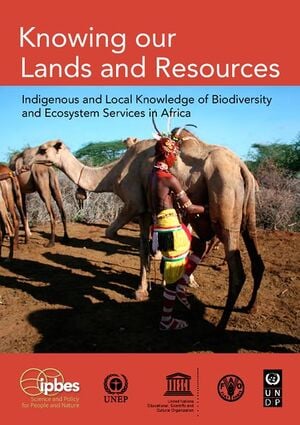
 Green Deal: pioneering proposals to restore Europe's nature by 2050 and halve pesticide use by 2030, ec.europa.eu (Jun 22, 2022)
Green Deal: pioneering proposals to restore Europe's nature by 2050 and halve pesticide use by 2030, ec.europa.eu (Jun 22, 2022)
The UN Decade on Ecosystem Restoration 2021-2030 is a rallying call for the protection and revival of ecosystems all around the world, for the benefit of people and nature. It aims to halt the degradation of ecosystems and restore them to achieve global goals. The United Nations General Assembly has proclaimed the UN Decade and it is led by the United Nations Environment Programme and the Food and Agriculture Organization of the United Nations. The UN Decade is building a strong, broad-based global movement to ramp up restoration and put the world on track for a sustainable future. That will include building political momentum for restoration as well as thousands of initiatives on the ground.[1]
The decade was conceived as a means of highlighting the need for greatly increased global cooperation to restore degraded and destroyed ecosystems, contributing to efforts to combat climate change and safeguard biodiversity, food security, and water supply. W
How to get involved[edit | edit source]
News and comment[edit | edit source]
2021
Climate and nature crises: solve both or solve neither, say experts, Jun 10[2] ...Biodiversity news
UN calls on countries to meet commitments to restore one billion hectares of land, Jun 3[3] One billion hectares of land is an area about the size of China. Countries also need to add similar commitments for oceans.
See also: decadeonrestoration.org
Resources[edit | edit source]
- Becoming #GenerationRestoration: Ecosystem Restoration for People, Nature and Climate, Jun 3, 2021 unep.org
- Framework for Ecosystem Restoration Monitoring, fao.org. The Framework incorporates the Drylands Restoration Initiatives Platform, which includes an interactive geospatial mapping tool to assess the best locations for forest restoration. added 15:53, 4 June 2021 (UTC)
- Ecosystem Restoration Playbook, unenvironment.widen.net, added 08:36, 27 April 2021 (UTC)
- See also: decadeonrestoration.org
Involvement of communities[edit | edit source]
"...the beauty of ecosystem restoration is that it can happen at any scale – and everyone has a role to play."[4]
Restoration must involve all stakeholders including individuals, businesses, associations, and governments. Crucially, it must respect the needs and rights of Indigenous Peoples and local communities, and incorporate their knowledge, experience and capacities to ensure restoration plans are implemented and sustained.
Communities living across almost two billion of degraded hectares of land include some of the world’s poorest and marginalized.[5]
Massive gains await us[edit | edit source]
The UN estimate that every 1 USD invested in restoration creates up to USD 30 in economic benefits.[6]
Proclamation[edit | edit source]
During the Bonn Challenge 3.0 high-level meeting in March 2018, El Salvador announced plans to propose a United Nations Decade on Ecosystem Restoration 2021–2030, aimed at boosting existing efforts to restore degraded ecosystems. El Salvador's leadership on ecosystem restoration arose out of its support for the Bonn Challenge, which aims to restore 350 million hectares of degraded ecosystems globally by 2030, and endorsement of the New York Declaration on Forests. As one of the six Bonn Challenge pilot countries, El Salvador has pledged to restore 1 million hectares, equivalent to half of the country’s territory.
71 countries supported the proposal at its presentation by El Salvador’s Minister of Environment and Natural Resources, Lina Pohl, to the 73rd session of the United Nations General Assembly in September 2018. W
Rationale[edit | edit source]
The United Nations Decade on Ecosystem Restoration 2021-2030 will focus on balancing ecological, social and developmental priorities in landscapes where different forms of land use interact, with the aim of fostering long term resilience
The restoration of 350 million hectares of degraded terrestrial and aquatic ecosystems by 2030 could generate US$9 trillion in ecosystem services and remove 13 to 26 gigatons of greenhouse gases from the atmosphere. The benefits obtained from ecosystem generation on average exceed the costs of the initial investment tenfold, whereas the cost of inaction is at least three times the cost of ecosystem restoration. W
Opportunity and aims[edit | edit source]
Around 2 billion hectares of degraded lands worldwide have potential for ecosystem restoration. Most of the rehabilitation work could take the form of “mosaic restoration”, in which forests are combined with protected areas, agriculture, waterbodies, and human settlements on a landscape-wide scale. The UN Decade aims to promote a concerted and holistic landscape-focused approach to the interdependence of ecosystems, human needs, and biodiversity, to accelerate the progress needed to maintain and restore ecosystems. W
Links to other initiatives[edit | edit source]
Ecosystem restoration is recognized as a key component in achieving targets under existing international conventions and agreements. These include the 2030 Agenda for Sustainable Development and, under it, the Sustainable Development Goals (SDGs), the Strategic Plan for Biodiversity 2020 and its Aichi Biodiversity Targets, the United Nations Framework Convention on Climate Change and Paris Agreement, the United Nations Convention to Combat Desertification and its target of Land Degradation Neutrality, the Ramsar Convention, and the United Nations Strategic Plan on Forests 2017 – 2030.
Ecosystem restoration will contribute to all 17 Sustainable Development Goals, in particular to SDG15 (Life on Land), SDG 2 (Zero Hunger), SDG 6 (Clean Water and Sanitation), SDG 7 (Affordable and Clean Energy), SDG 12 (Responsible Consumption and Production), SDG 13 (Climate Action), SDG 14 (Life Below Water) and SDG 17 (Partnerships for the Goals). W
See also[edit | edit source]
- Ecosytem restoration
- Biodiversity
- Climate action
- Coasts
- Open spaces
- Reduce, reuse, repair and recycle
- Rural sustainability
- Trees, woodland and forest
- Urban sustainability
- Bridging the social justice and environmental movements
- Environmental justice (category)
local information can be found, or shared, via our many location pages
External links[edit | edit source]
- UN Decade on Ecosystem Restoration W
- UN Decade on Restoration
